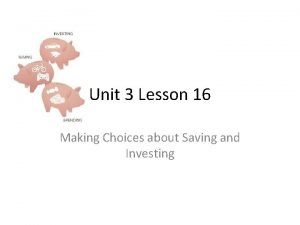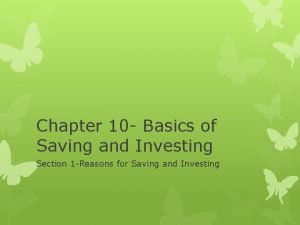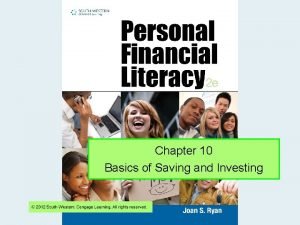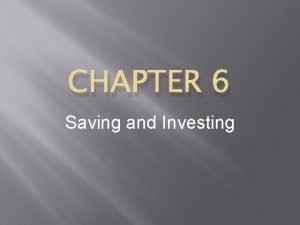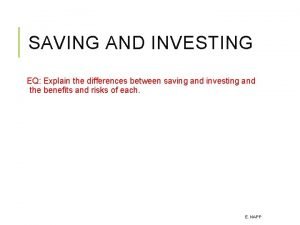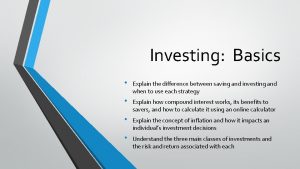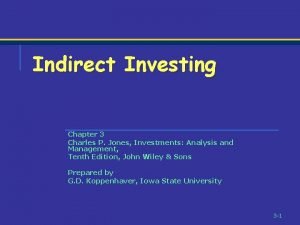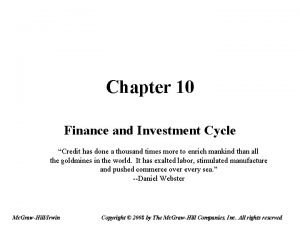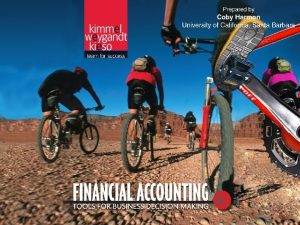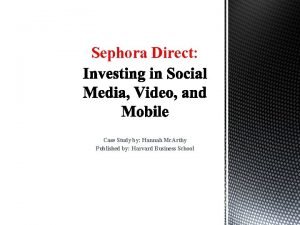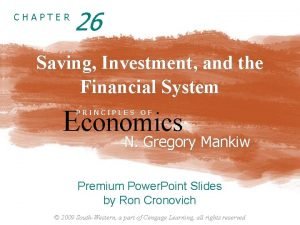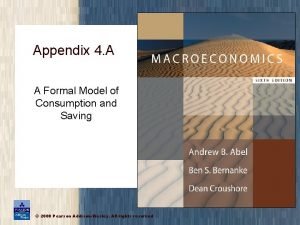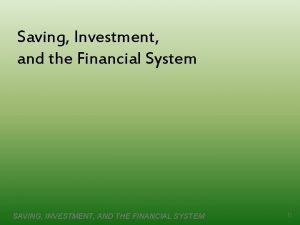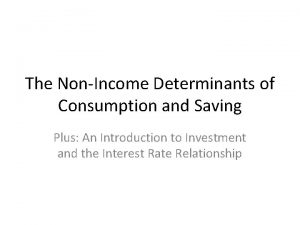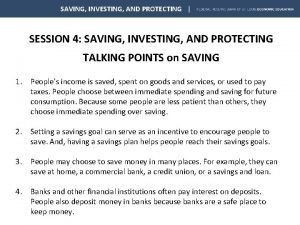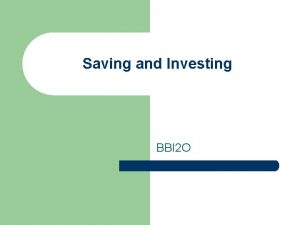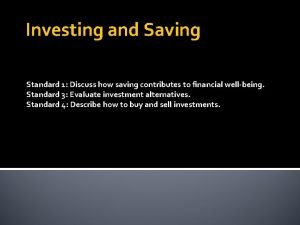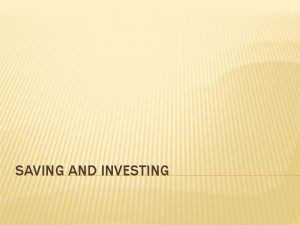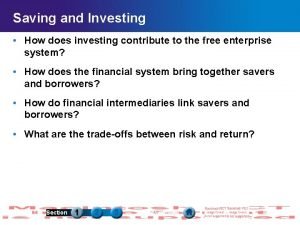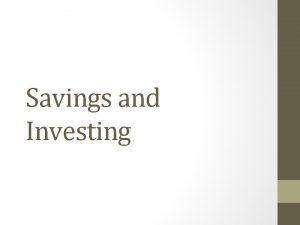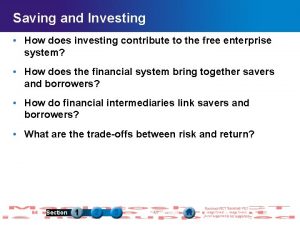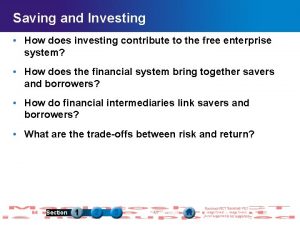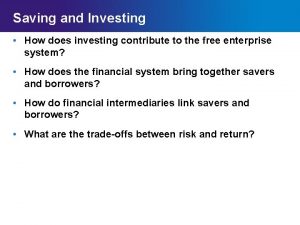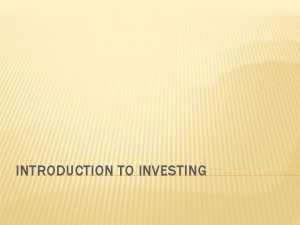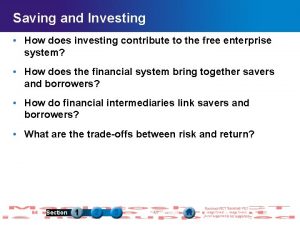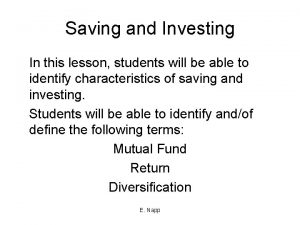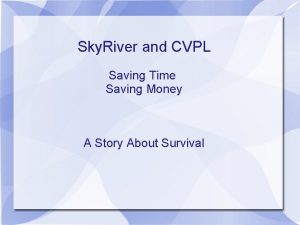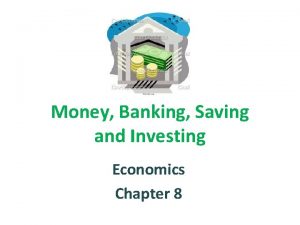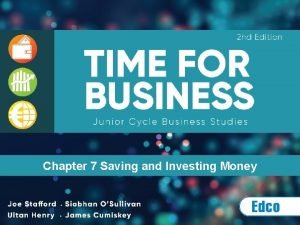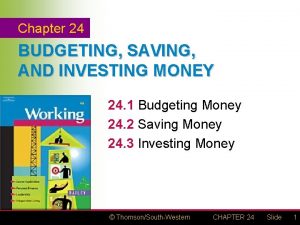Money Saving and Investing In this lesson students


























- Slides: 26

Money, Saving, and Investing

* In this lesson, students will be able to identify characteristics of money. * Students will be able to identify and/or define the following terms: * Money * Commodity Money * Representative Money * Fiat Money

We use it every day but what is money?

Money – Money is used as: A. a medium of exchange: As a medium of exchange, money precisely measures value for exchanging it for goods and services. B. a unit of account: money can be precisely counted so that financial institutions can handle accounts. C. a store of value: it’s not perishable – it can theoretically be saved forever.

Money, Again – As a unit of account, money is used to precisely figure out the value of goods and services. – An expensive sweater is considered more valuable than a cheaper sweater. A Mercedes costs more than a Chevy. – Finally, money is a store of value. Money holds its value even if it is not used (though inflation affects money).

Not All Money is the Same – Commodity money can be used as money but also has value in itself. The barter system was based on commodity money. –An example of commodity money is salt. Salt was once used in some societies as money. –Salt could be used as money or eaten.

Representative Money –Representative money is another type of money. –An example of representative money is an I. O. U. or a check. –The paper that the I. O. U. is written on can be exchanged for something valuable.

Our dollars were once backed by gold. You could exchange a dollar for gold.

Fiat Money –Fiat money is our money today. –Our money has value because the government states that it is an acceptable means to pay debts and the people accept this as true. There is nothing backing up our money other than government influence and widespread public acceptance.

Six Characteristics of Money – There are six characteristics of money. Money should be: 1. Portable 2. Divisible 3. Durable 4. Uniform 5. Accepted 6. Be in limited supply. – The more money there is in circulation means that each unit of money retains less value and vice versa.

Saving and Investing In this lesson, students will be able to identify characteristics of saving and investing. Students will be able to identify and/of define the following terms: Return Diversification

Saving and Investing –When a person saves money, he is storing money. –When a person invests money, he is trying to significantly increase his money. –Investing money involves risk but also potentially can increase how much money you have. The riskier the investment, the greater the potential reward, usually.

People invest when they buy stocks and bonds. These are investments are called securities.

Stocks and Bonds –When a person buys stock, he is buying partial ownership in a corporation. –When a person buys a bond, he is loaning money to a corporation or government. –It is important to remember the investment poem: Stocks, you own. Bonds, you loan.

There are many financial companies, known as intermediaries, that can help people invest.

Financial Intermediaries – A financial intermediary transfers money from savers to borrowers. For example, if you buy 100 shares of stock at $10 per share, that’s a total of $1000 you paid to the intermediary. That money is then used by the intermediary to buy other securities or to finance loans. In other words, the intermediary borrows that money you paid for your stock to try and make more money. – Financial intermediaries can help a person invest. Investors must be careful who they do business with, however. If the financial planners you work with ARE NOT fiduciaries, they are not required by law to lead you toward investments that help you primarily. They can sell you securities that will be bad for you but make them money, in other words. Fiduciaries have to help you by law, not themselves. – Banks, finance companies, and money management firms are examples of financial intermediaries. Many people do retail investing, where they get an account with TD Ameritrade, for example, and buy securities through them.

By investing in a variety of stocks and bonds, a person reduces his risk.

Diversification –The idea of spreading out investments into different sectors of business in order to reduce risk is called diversification. –By investing in a variety of stocks and bonds, the investor is less likely to lose his entire investment. If one or two sectors have a bad run, other sectors will help to defray the money lost.

Returns – A return is money made above the investment. – There are two primary ways that investors realize returns. The first is through dividends (usually done each quarter, a company will give investors a piece of the quarterly profits in a lump sum) while the second way is to sell your shares of stock at a price higher than what you bought it for. This is referred to as capital gains.

Bonds – Bonds are loans than investors give to a corporation or a government. – The corporation or government must repay the loan with interest over a certain specified length of time, usually at least one year. – Corporate bonds are riskier than government bonds, generally. If a company goes out of business and they owe you for a bond, you lost your money.

The Stock Market In this lesson, students will be able to identify characteristics of the stock market. Students will be able to identify and/or define the following terms: Stock Dividend Capital Gain and Capital Loss

Stocks –When a person buys stock, he is buying partial ownership in a corporation. –If the corporation prospers, the investor prospers. –If the corporation fails, the investor can lose his investment.

Profiting from Stocks –There are two ways a stock investor can profit from his stocks, those being dividends and capital gains, both of which are covered on slide #19.

However, sometimes a capital loss occurs. A capital loss occurs when an investor sells his stock for less than the original purchase price. However, if your stocks are losing value, it isn’t a capital loss unless you SELL the stock. If you hold on to the stock hoping it will recover in time, it’s a paper loss only. Once you sell, you not only realize a capital loss, you also have to pay taxes on the money you got back from selling the stock.

Bull and Bear Markets –A bull market occurs when the stock market rises steadily over a period of time. –A bear market occurs when the stock market falls over a period of time. –Since 2009, we have been in a bull market, which is a long time. Many investors today worry that a bear market is right around the corner.

While investors may not like bear markets because selling prices are low, bear markets are excellent times for buying shares at lower prices. When looking for capital gains returns, you always want to buy low and sell high.
 Lesson twelve saving and investing
Lesson twelve saving and investing Unit 3 lesson 2 saving and investing
Unit 3 lesson 2 saving and investing Chapter 10 basics of saving and investing
Chapter 10 basics of saving and investing Holding a variety of investments to reduce risk
Holding a variety of investments to reduce risk Chapter 6 saving and investing
Chapter 6 saving and investing Explain the investment poem concerning stocks and bonds.
Explain the investment poem concerning stocks and bonds. Explain the difference between saving and investing
Explain the difference between saving and investing Direct investing vs indirect investing
Direct investing vs indirect investing Dana damian
Dana damian Two brothers are saving money to buy tickets
Two brothers are saving money to buy tickets The closing of a persuasive request should
The closing of a persuasive request should Anecdotes of rizal
Anecdotes of rizal Tom buchanan symbolism
Tom buchanan symbolism Money smart money match
Money smart money match Money on money multiple
Money on money multiple The great gatsby historical background
The great gatsby historical background Tom buchanan character traits
Tom buchanan character traits Financing and investing cycle
Financing and investing cycle Common stock in cash flow statement
Common stock in cash flow statement Operating activities
Operating activities Sephora direct case study
Sephora direct case study 10 labour saving devices and their uses
10 labour saving devices and their uses Mankiw chapter 26 solutions
Mankiw chapter 26 solutions The life-cycle model of consumption and saving
The life-cycle model of consumption and saving What is national savings
What is national savings Heat transfer grade 7
Heat transfer grade 7 Determinants of consumption
Determinants of consumption

